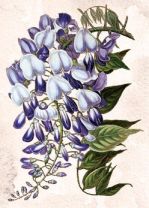Weeping Wisteria
By Audrey Stallsmith

There was a wistaria vine blooming for the second time that summer on a wooden trellis before one window, into which sparrows came now and then in random gusts, making a dry vivid dusty sound before going away. . .
Absalom, Absalom!--William Faulkner
Wisteria (AKA wistaria) is one of those plants that people complain about, either because it is too vigorous a vine or won't bloom for them--and sometimes both! I complain because mine was going to bloom for the first time this year, until the buds got blasted by a May frost.
But I have to concede that frost more closely resembled an actual freeze, and even the hardiest of my plants were affected. So this wasn't a case of a delicate southern belle not being able to withstand PA temperatures!
A few of the smaller buds did survive--even though my cultivar, 'Blue Moon,' is actually descended from one of those southern types, Wisteria macrostachya or Kentucky wisteria. So it is supposed to bloom, like Faulkner's did, more than once a year. I will keep my fingers crossed that it performs better in summer's heat.
If you are purchasing wisteria, you should probably opt for an American cultivar as well, since the plain Chinese (Wisteria sinensis) and Japanese (Wisteria floribunda) types are often grown from seed. And those seedlings can take ten years or more to bloom! (Cultivars, on the other hand, are usually propagated by cuttings or layering.) Not to mention that the Oriental varieties are much more invasive than native wisterias like frutescens and macrostachya.
The world's largest wisteria, a Chinese type, covers an acre or more in Sierra Madre, California and weighs about 250 tons. Not to mention that the roof of the original house to which it was attached eventually collapsed under the weight of it. Martha Stewart suggests training Japanese wisteria to grow as a small tree, which is one way to keep it off your roof!
Frutescens grows wild across much of the southeastern United States, especially in damp forests and near streams. But it is Louise Beebe Wilder insists in The Fragrant Path, "perfectly hardy at least as far north as Northern New York." Most sources, however, consider frutescens only suitable for Zone 6 or higher, so it is a mainstay of those often lachrymose southern novels!
Wisteria was originally known as glycine after the Greek glykys or "sweet." But it was renamed in honor of an American anatomist named Caspar Wistar.
That's about as close as it ever came to medicine, however, as the seeds and pods of wisteria are quite poisonous. Altough I have heard of people cooking the flowers in fritters, I would avoid consuming any part of the wisteria plant myself. Besides that seems like a dreadful waste to those of us who are still waiting on blooms!
Wisteria plate is from Paxton's Magazine of Botany, courtesy of the University of British Columbia library.








